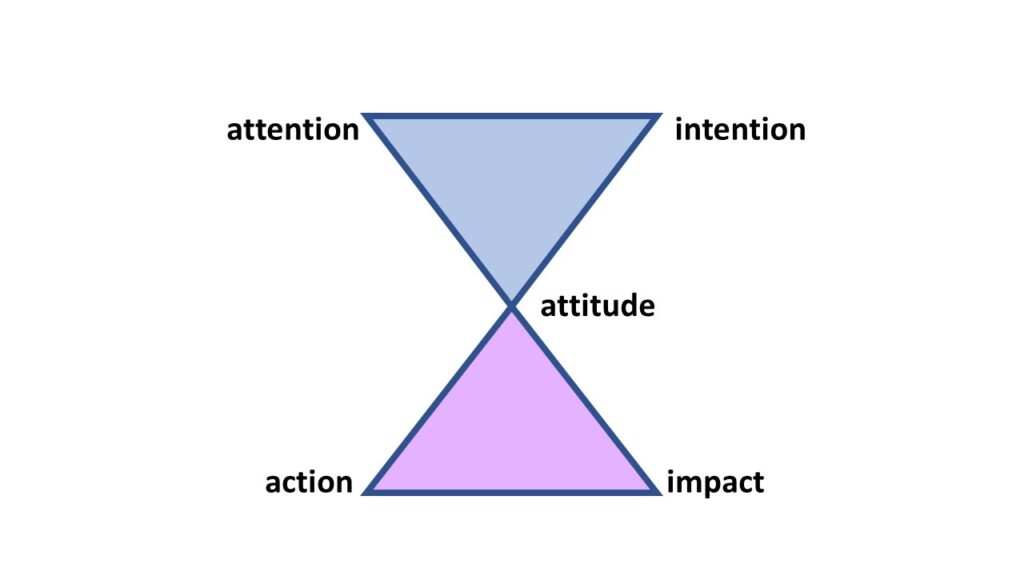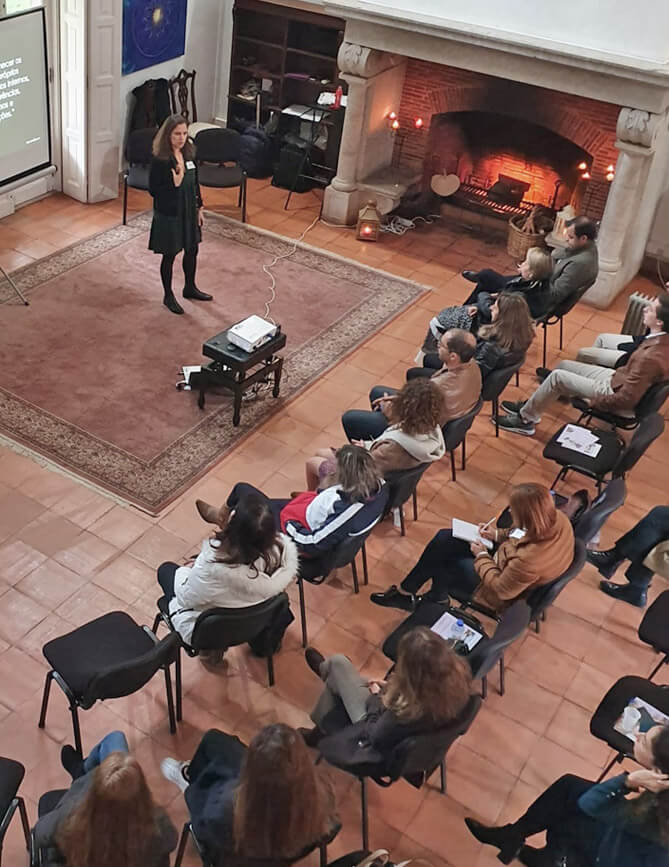A complete mindfulness practice deals with the training of the five characteristics that we identified in the first part of this article: attention, intention, attitude, action, and impact. This drawing illustrates these five elements and establishes their main relationships.

Any deep mindfulness practice includes integrating the two levels that the drawing clearly identifies:
- First, we practice seated in stillness (either on the floor on a cushion or in a chair) bringing attention to an object (for example, breathing or any other part of the body), with a specific intention (for example, gratitude) and from a freely chosen attitude (for example, curiosity and benevolence). This is how we train the upper triangle, the triangle we recognize as our “being.” We often refer to this type of training as “dedicated practice”.
- Then, we practice by doing “movement”, any movement however picturesque it may be, to train the three elements of the lower triangle: a freely chosen attitude (e.g., curiosity and care), an action that occupies movement (e.g., eating or walking, but also listening, talking, parenting, or making love), and impact (e.g., the impact in ourselves; the impact in the “small others”, those who participate in the situation; and the impact on the “big others”, everything that makes up the unity of life and that is not present). By training the lower triangle, we train the “doing”. This training is often referred to as “integrated practice“.
When we start with training, especially if our challenge is to calm the mind and find an emotional balance, we focus on the upper triangle and we engage ourselves in practicing the stillness of being by training attention, intention and attitude. However, as we progress through practice, it is very important to extend it towards any “doing” by embedding also action and impact.
This is the only way that will take us to a deeper and more complete practice so we can enter into an improved state of being and doing, more conscious, mindful some would say, where we “notice” everything that intervenes and everything that surrounds the self, the others with whom I interact, and any other life which participates even if it is not present in the situation.
This is the reason why “meditation” and “mindfulness” are about practice, practice, and more practice, always with lots of patience. This I like to label playfully as “the 4Ps of meditation“: p-ractice, p-ractice, p-ractice with p-atience. Because it is in practice and only in practice where we transcend our myriad of “autopilot modes” and we can freely choose new ways of being and doing. Also, because it is only with repeated practice that the dynamics of neuroplasticity reconfigure our neural connections and consolidate the new that we are practicing in the structure and functioning of the brain.
At this point, the meaning of the three basic mindfulness practices reveals easily:
- focused attention helps us maintain attention where we choose it to be;
- open attention helps us to open attention to multiple events and observe them simultaneously;
- body scan helps us to include the body in our experience of being and doing.
In the same way, full training has an effect on our “meta-attention“. In a first phase, meta-attention manifests as the ability to self-observe our own experience of mind. With practice, meta-attention grows and expands into our body experience, into the action we take, and into the impact we generate. This is how we begin to experience “presence”, that “noticing” of being fully in the here and in the now. And it is only with repeated practice that this presence gets “embodied” (which is the same as saying that it is integrated into the body) and facilitates a much fuller and more harmonious life experience.
This recognition that the full practice of mindfulness includes repeated training of the five elements (attention, intention, attitude, action, and impact) allows us to enter into a deeper self-knowledge and greater self-management. And it comes only from this recognition that we will be able to manage who we are and offer it to others in wholeness, with respect and with responsibility.
My own experience shows me that “impact” is the great forgotten, the lost piece of many of the proposals of mindfulness and meditation, especially when embracing impact on the three levels:
- the impact that my being and my doing causes “on my own life experience”;
- the impact that my being and my doing causes “in the life experience of those with whom I interact and share a life”;
- the impact that my being and my doing causes “in all that and all those who, being part of life, are not present”.
Playfully, I like to extend the meta-attention by choosing to “step into the action”, which is the same as choosing to act, by experiencing a “triple-like” (I like what I do, I like how I do it and I like why I do it), but also by embracing “impact on its three levels”, always looking for a “triple-win” (I win; the one or those with whom I interact win; and whatever is not present wins).
I believe that the main the reason why “impact on its three levels” is always forgotten happens because of our long tradition of linear thinking, of that simple “cause and effect” understanding of action. Surely, it is also the case that globalization makes it difficult to anticipate the effects of our actions since they contribute in seemingly infinite chains of causality and they manifest themselves in places and with people which are very distant and fully unknown. At this point, no doubts, the exploration of “systems thinking” will help a lot to understand the causality of our actions in all their complexity and all their circularity.
Finally, this recognition that the complete practice of mindfulness includes the repeated training of the five elements (attention, intention, attitude, action, and impact) leads us to understand why we can and should take the practice to all aspects of our lives. This helps to explains also that most of the proposals around are simply different flavors of the same, where each flavor concretizes the care of attention, intention, and attitude in a specific field of action:
- conscious leadership: takes care of the action of “leading” and the “impact” it causes;
- conscious collaboration: takes care of the action of “collaborating” and the “impact” it causes;
- conscious entrepreneurship: takes care of the action of “entrepreneurship” and the “impact” it causes;
- conscious parenting: takes care of the action of “parenting” and the “impact” it causes;
- conscious aging: takes care of the action of “aging” and the “impact” it causes;
- conscious eating: takes care of the action of “eating” and the “impact” it causes;
- conscious sexuality: takes care of the action of “making love” and the “impact” it causes;
- et cetera, et cetera, et cetera.
Perhaps, and this is how we like to thing at The School of We, a more beautiful and better world is within our reach. And the way forward has an easy, already identified first step: a better self, which is the same as saying “a better being and a better doing” trained from the practice of meditation and mindfulness.

